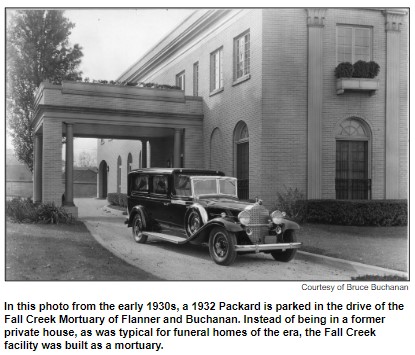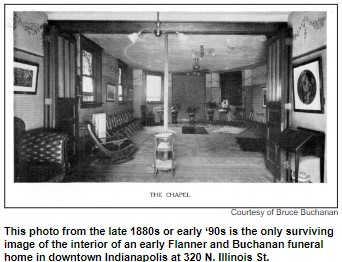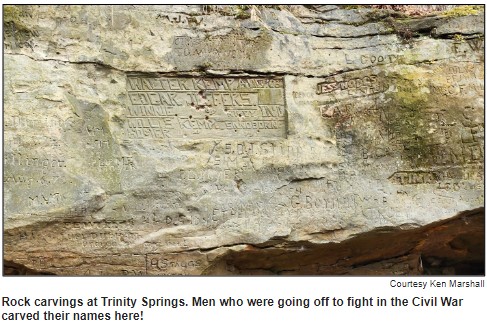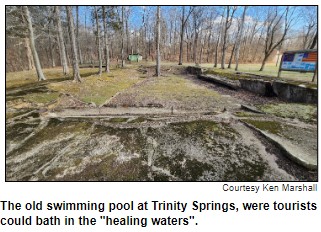A live weekly radio adventure through Indiana history with host Nelson Price. Airs live on Saturdays from noon to 1 pm ET at WICR 88.7 fm in Indianapolis.
You can listen to WICR anywhere on your mobile device or at home on your smart speaker. Go to www.wicronline.org to listen live. You can also ask your smart speaker to "play WICR" OR "play 88.7 the Diamond".
March 18, 2023
Funeral business evolution and civic involvement in Indy

Ever since the 1820s, when David Buchanan arrived by covered wagon in the Indianapolis area and opened a tavern before becoming a farmer, the Flanner and Buchanan families have been intertwined with city history. Flanner and Buchanan Funeral Centers is a 142-year-old, family-owned business that began during an era when funerals and visitations typically were held in the parlors of private homes (hence, the derivation of the term funeral parlor). Before that, in the mid-1800s, undertakers often were carpenters.

As the funeral business evolved (Flanner and Buchanan opened the first crematorium in Indianapolis in 1904), so did the civic impact of members of the Flanner and Buchanan families, who were brought together by marriage in the 19th century. Frank Flanner, who began in the mortuary business in 1881, founded Flanner House (initially known as Flanner Guild House), a nonprofit to assist African Americans, including former enslaved people who had come to Indianapolis. His sister, Anna Flanner Buchanan, helped start the first YWCA in the city.
 All of that and more will be explored during our show when Bruce Buchanan, the CEO of Buchanan Group Inc. (which includes Flanner and Buchanan Funeral Centers), the fourth generation owner, is Nelson's studio guest. The massive Community Life Center on the city's far eastside, a multi-purpose event space owned by Flanner and Buchanan, and adjacent Washington Park East Cemetery are on the site of David Buchanan's farmland in the 1830s. The multi-generational impact of the families on the funeral business and civic affairs is described in a lavishly illustrated book, Building Community: The Flanner and Buchanan Families of Indianapolis written by local author Julie Young.
All of that and more will be explored during our show when Bruce Buchanan, the CEO of Buchanan Group Inc. (which includes Flanner and Buchanan Funeral Centers), the fourth generation owner, is Nelson's studio guest. The massive Community Life Center on the city's far eastside, a multi-purpose event space owned by Flanner and Buchanan, and adjacent Washington Park East Cemetery are on the site of David Buchanan's farmland in the 1830s. The multi-generational impact of the families on the funeral business and civic affairs is described in a lavishly illustrated book, Building Community: The Flanner and Buchanan Families of Indianapolis written by local author Julie Young.
The book describes the prominence of literary great Janet Flanner (1892-1978), Frank Flanner's daughter, who became famous beginning in the 1920s as a Paris-based writer. During our show with Bruce Buchanan, we will explore Janet's impact (she documented the early rise of Adolph Hitler) as well as family tragedies. They include the suicide in 1912 of mortician Frank Flanner, who drank a poisonous concoction, and the drowning deaths of two young Buchanan brothers in Fall Creek during the 1930s.
By then, Flanner and Buchanan had opened Fall Creek Mortuary, a structure that was built as a funeral center during an era when that was unusual; most were located in converted houses. Fall Creek Mortuary, which had a built-in organ and served as the flagship of the Flanner and Buchanan operation for decades, eventually was demolished in the 1990s.
 According to Building Community, the word "undertaker" was coined in the 19th century to describe someone, typically a carpenter, who was willing to "undertake the unpleasant duty" of handling the final presentations of the deceased. By 1887, when Frank Flanner persuaded his brother-in-law Charles Buchanan, Anna's husband, to join him in the business, the term undertaker was being dropped in favor of the more professional term of "funeral director". Like the Flanners, Charles Buchanan became immersed in civic affairs, including crusading for the creation of the Indiana Dunes State Park.
According to Building Community, the word "undertaker" was coined in the 19th century to describe someone, typically a carpenter, who was willing to "undertake the unpleasant duty" of handling the final presentations of the deceased. By 1887, when Frank Flanner persuaded his brother-in-law Charles Buchanan, Anna's husband, to join him in the business, the term undertaker was being dropped in favor of the more professional term of "funeral director". Like the Flanners, Charles Buchanan became immersed in civic affairs, including crusading for the creation of the Indiana Dunes State Park.
Frank Flanner convinced other civic leaders to help launch Flanner House, a nonprofit that continues to this day. Its dedication ceremony in the early 1900s was attended by Booker T. Washington, who stayed at Frank Flanner's house when he was turned down by local hotels. Frank Flanner's other civic involvement included helping launch what became the Herron School of Art and Design.
 Janet Flanner, Frank Flanner's daughter, became one of the first movie critics in the country, writing about silent films for the Indianapolis Star. Beginning in the 1920s, though, she was a correspondent for The New Yorker magazine based in Paris. That's where she befriended other American expatriates including legendary novelists Ernest Hemingway and F. Scott Fitzgerald.
Janet Flanner, Frank Flanner's daughter, became one of the first movie critics in the country, writing about silent films for the Indianapolis Star. Beginning in the 1920s, though, she was a correspondent for The New Yorker magazine based in Paris. That's where she befriended other American expatriates including legendary novelists Ernest Hemingway and F. Scott Fitzgerald.
Other members of the extended Flanner and Buchanan families also carved out careers beyond the funeral business. Paul Buchanan Jr., the father of our guest Bruce Buchanan, was a well-known judge and an art collector until his death in 2008. His vast collection of Brown County artwork now is displayed at Flanner and Buchanan funeral centers.
The family's heritage is Scottish. David Buchanan, the pioneer who came to the new city of Indianapolis in the 1820s, had been born in Virginia. The farm that he started in far-eastern Marion County was on the National Road (now U.S. 40, or Washington Street, as it's known in the city). The Community Life Center that opened in 2001 on the farm's site is a building of 20,000 square feet that has become a venue for weddings, receptions and community events as well as celebrations of life and funeral visitations.

Your contributions help keep Hoosier History Live on the air, on the web and in your inbox!


 French Lick spring
French Lick spring We probably can't say often enough that we are an independent production group, and that we make our own business and editorial decisions! Please don't necessarily contact the radio station for help. Our contact information is on our website at
We probably can't say often enough that we are an independent production group, and that we make our own business and editorial decisions! Please don't necessarily contact the radio station for help. Our contact information is on our website at 





